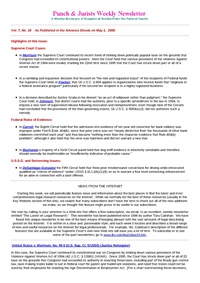Loaded on
May 1, 2000
published in Punch and Jurists
May 01, 2000
Here the Fifth Circuit held that three prior misdemeanor convictions for driving while intoxicated qualified as "crimes of violence" under USSG § 2L1.2(b)(1)(B) to warrant a four level sentencing enhancement in connection with a later offense.
The defendant in this case pled guilty to illegal reentry by a deported alien ...
Loaded on
May 1, 2000
published in Punch and Jurists
May 01, 2000
In this case, the defendant sold a total of five ounces of methamphetamine to a confidential informant on two occasions. Because of his prior convictions, he qualified as a career offender under the Guidelines, and his Guideline sentence range was 188 to 235 months. The Court noted that the 43 ...
Loaded on
May 1, 2000
published in Punch and Jurists
May 01, 2000
At issue in this appeal is the evidence offered by the prosecution to establish the interstate nexus prong of § 922(g)(1) -- "in or affecting commerce." Although the majority concluded that the testimony of a police officer on that issue (who had not been qualified as an expert), Judge Torruella ...
Loaded on
May 1, 2000
published in Punch and Jurists
May 01, 2000
Here the Court held that an assertion in the defendant's presentence report that he would have stolen all 87 guns on display in a store he attempted to rob was insufficient to justify a six-level enhancement for a crime involving more than 50 guns.
In this case the defendant and ...
Loaded on
May 1, 2000
published in Punch and Jurists
May 01, 2000
As this case shows, one of the most conceptually confusing topics in criminal law is the use of “prior bad acts” evidence during a criminal trial. That issue is extremely important, because, as one court has observed: “When jurors hear that a defendant has on earlier occasions committed essentially the ...
Loaded on
May 1, 2000
published in Punch and Jurists
May 01, 2000
This case is noted for its detailed discussion of the admissibility of testimony by police officers that trained canines reacted positively to the scent of drugs on currency. Several of the defendants in this large-scale drug prosecution argued that such evidence should have been excluded, pursuant to Fed.R.Evid. 403, because ...
Loaded on
May 1, 2000
published in Punch and Jurists
May 01, 2000
The Court summarized the issue raised in this appeal by reporting as follows: "On January 31, the district court held a status conference on various discovery disputes. Just prior to the conference, Hardeman filed a status memorandum reporting on the status of discovery and requesting several discovery orders from the ...
Loaded on
May 1, 2000
published in Punch and Jurists
May 01, 2000
This is an astonishing case - not just because of the actions of the Immigration Judge (IJ) in denying the petitioner her statutory right to counsel (pursuant to 8 U.S.C. § 1362), but also because of the dissent of Judge O'Scannlain who concluded that the petitioner had not made out ...
Loaded on
May 1, 2000
published in Punch and Jurists
May 01, 2000
In this case, the First Circuit joined a majority of the Circuits in holding that a district court may use post-sentencing rehabilitation to depart downward in a sufficiently exceptional case; and its analysis compared the decisions of the other Circuits.
This case involved a sentence agreement entered into by the ...
Loaded on
Dec. 20, 2001
published in Punch and Jurists
May 01, 2000
In this decision a divided Supreme Court adopted another expansive view of the scope of 18 U.S.C. § 666, the statute that makes it a Federal crime to engage in certain acts of theft and fraud against organizations that receive funds under the plethora of Federal assistance programs. The precise ...
Loaded on
Jan. 29, 2002
published in Punch and Jurists
May 01, 2000
In this case, the Supreme Court continued its constitutional war on Congress by striking down various provisions of the Violence Against Women Act of 1994 (42 U.S.C. § 13981) (VAWA). Since 1995, the Court has struck down part or all of 22 laws on the grounds that Congress had exceeded ...
Loaded on
Oct. 7, 2003
published in Punch and Jurists
May 01, 2000
Justice Scalia set the tone for this case when he candidly noted in his dissent that “[t]his is not an important case, since it deals with the interpretation of a statute that has been amended to eliminate, for the future, the issue we resolve today.” Reading this decision, one will ...
